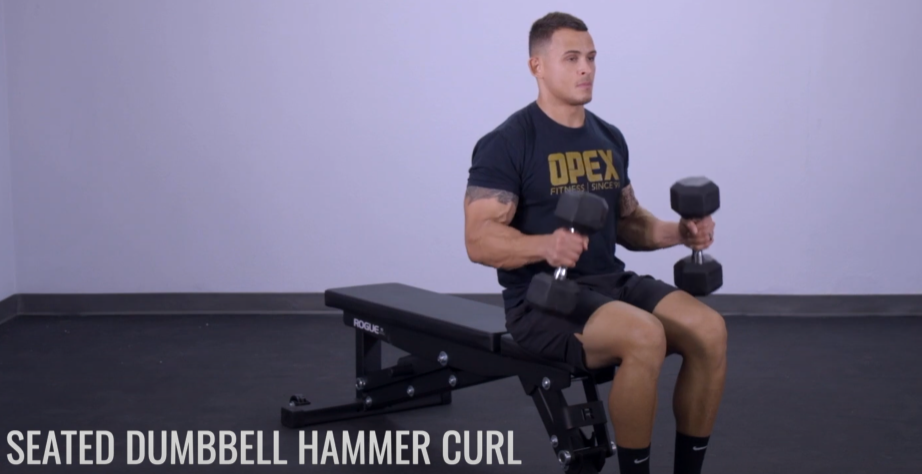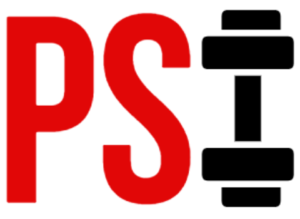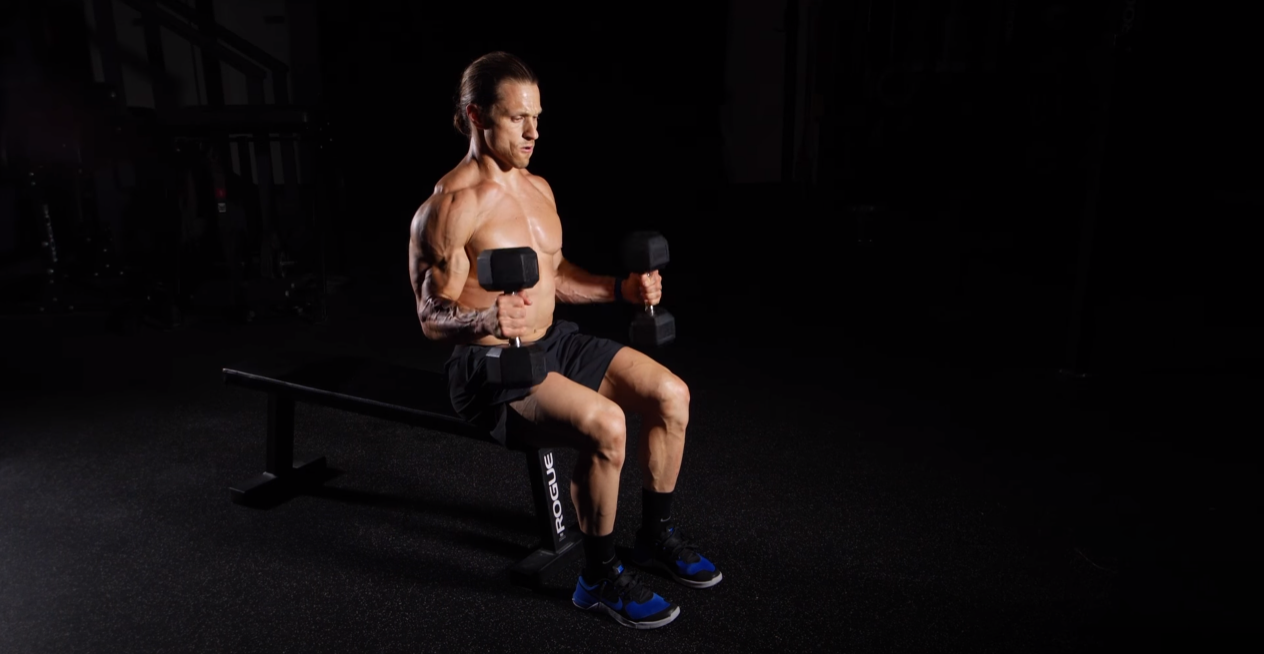Has anyone ever told you it’s not good to lift heavy weights? Wrong. Some of the best arm gains come from lifting heavy. And no exercise delivers that better than a seated hammer curl.
Seated hammer curls are a must-have in your arsenal of arm exercises. They focus on building muscle and strength in the biceps and forearms, which helps you become more powerful when performing other athletic activities. Plus, if you’re looking for an exercise that’ll help sculpt the perfect pair of arms for summer, this is it!
Still unsure of what a seated hammer curl is? Or why it deserves a place in your workout routine? Not to worry, we’ve got all the details covered—including form tips and muscles worked—in this article. Let’s get started!
What Are Seated Hammer Curls?
Put your arms to work with seated hammer curls! If you want to build strength and size in your biceps and forearms, this exercise is the perfect way to make that happen.
So, what are seated hammer curls? Basically, rather than standing up and curling your weights upward, you’ll be sitting down in a chair for this one. Your feet should be flat on the floor and your knees spread wide. You’ll then hold two dumbbells with palms facing inwards, keeping your upper arms still at all times. From there, you’ll bend one arm and curl the weight up towards your shoulder without rotating the wrist.
Sounds easy enough right? Seated hammer curls are a great move for anyone looking to take their arm gains to the next level – so give it a try the next time you’re hitting those biceps!
Benefits of Seated Hammer Curls
Not only do seated hammer curls look cool and make you feel like a professional fitness guru—they offer a range of benefits for your arms.
For starters, the seated hammer curl is an effective way to increase bicep size and strength. You can also see improvements in your wrist stability, as the exercise helps to strengthen the wrists in multiple directions as well as improve coordination.
Lastly, seated hammer curls are also known to help with grip strength. Your grip is used in a ton of different upper body exercises such as deadlifts and pull-ups, so having strong hands will only complement your workouts further.
Incorporating this exercise into your routine will give you stronger, muscular arms that you can be proud of!
Here’s a quick demonstration video:
Seated Hammer Curls VS Standing
Have you ever done standing hammer curls? They’re one of the most popular ways to target the biceps and forearms — and they look really cool. But if you’ve ever done them, you know they can be tricky to master. That’s because standing hammer curls can be pretty prone to ‘swaying’, decreasing the activation of the target muscle.
So what’s the solution? Seated hammer curls! They are identical to standing hammer curls, except for one key difference: instead of being performed standing up, seated hammer curls are performed while sitting on a bench or chair.
This simple adjustment has several awesome benefits:
- Your body weight is more stabilized, making it easier to focus on isolating your biceps and minimizing ‘swaying’
- You can lift a bit more weight
- Seated hammer curls are joint friendly variations that don’t put too much strain on your back and knees
See why seated hammer curls are such an awesome way to target your biceps? They enable you to lift heavier weights with greater control and precision — nothing beats mastering this exercise if your goal is awesome arm gains!
Muscles Worked With Seated Hammer Curls
Seated hammer curls are a fantastic exercise for isolating and targeting the biceps muscle, and you’re going to get awesome arm gains if you master this move.
But not only does the exercise target your biceps; it also targets two other muscles: the brachialis, and the brachioradialis.
Let’s look at these muscles in more detail:
- Biceps brachii: This muscle runs from your shoulder to your elbow. It helps flex the elbow (such as with a curl) as well as supinate the forearm (with an outward twist).
- Brachioradialis: This muscle is also located on your upper arm near the elbow and helps with forearm flexion.
- Brachailis: This muscle lies beneath the biceps muscle and gives your arm that added boost when curling, helping to bring the forearm up towards your shoulder in a flexing motion.
By mastering seated hammer curls, you’ll be targeting all 3 of these muscles for amazing arm gains!
Related: If you’re looking for more information on hammer curls, check out our Hammer Curl Ultimate Guide

How to Do a Seated Hammer Curl (Form & Technique)
It’s easy to get great arm gains with seated hammer curls. You just need to make sure you keep your form and technique on point. Here some tips to help you master this exercise:
Keep Palms Facing Inwards
Make sure to keep your palms facing inwards when you do a seated hammer curl. This will ensure that the biceps and forearms get a nice, even workout.
Upper Arms Still
Your upper arms should stay still throughout the entire exercise. This is important for maximizing the benefit of this exercise and avoiding any potential injuries. So, when curling, keep your upper arms in position parallel to the ground – don’t let them shift forward or backward as you lift up and down.
Lift Toward Shoulders
When curling, flex your elbows and lift the dumbbells toward your shoulders in a slow and controlled manner. Move in one continuous motion from start to finish. Avoid jerky movements or heavy breathing as this can lead to injury or improper form during the exercise.
Focus on Form Over Weight
If you’re a beginner, it’s best not to start off trying to heft really heavy weights right away with this exercise—instead focus on achieving perfect form when lifting one arm at a time before increasing weight over time as your strength increases.
Demonstration video:
Seated Alternating Hammer Curls: Benefits of Bilateral
When it comes to building strength, endurance and size in the biceps, seated alternating hammer curls are the way to go. This form of hammer curl is slightly different from regular hammer curls, as you switch arms after each bicep rep. As such, this exercise allows for greater attention and range of motion with each arm.
Hammer curls are a great exercise for developing the long head of the bicep brachii and the brachialis. The brachialis is a muscle that sits beneath the bicep brachii and gives your arms an overall thicker look. This can be further enhanced when doing seated alternating hammer curls because as you alternate arms you can focus on each one completely on its own.
The benefits of opting for bilateral curls in a seated position include:
- A safe training position that eliminates any potential lower back strain
- Improved stability and balance between opposing muscles
- Superior range of motion on both sides to target muscle fibers
- Enhanced mind-muscle connection to control movement more precisely
- Increased time under tension, helping to maximize strength gains
Seated Hammer Curls With Resistance Bands
If you’re looking to build bigger arms but don’t have dumbbells, seated hammer curls with resistance bands are the way to go. Band hammer curls involve keeping the elbows stationary at your sides, which is great for targeting the biceps and strengthening the grip, forearms, and biceps.
When done correctly—with full range of motion—resistance band hammer curls can be an effective exercise for building muscle.
To do seated hammer curls with resistance bands, start by running a resistance band under a chair. Sit down and grab each end of the band. Sit straight up with your back against the back of the chair (arms are still in a down position at this point). Keep your hands in a palms in (facing you) position. Then, curl the weight (band) up towards your shoulders.
Here’s a quick demonstration video:
,
If your resistance band has handles and is too long or too weak, you may want to grab onto it before the handles – grabbing the band itself instead of the handles.
Resistance band exercises allow you to build up strength without weights, so don’t forget to start slow with light resistance and build up over time!
If you need some resistance bands, check these out – They are similar to what is being used in the above video. I like them better than the resistance bands with handles.
Seated Incline Hammer Curls
The seated incline hammer curl is a variation of the seated hammer curl that uses an incline bench set to a 45-degree angle. This exercise allows you to keep your upper arm still and your palms facing inwards, as opposed to the traditional hammer curl that can cause you to rotate your wrist.
This variation also allows you to isolate your biceps better when lifting the dumbbells up towards the shoulder. It also improves range of motion and provides a great arm workout.
To perform the seated incline hammer curl, start by sitting on an incline bench set to a 45-degree angle, using an adequate weight and keeping your elbows by your side and feet planted on the floor. Then, hold both dumbbells and slowly lift them up towards your shoulder, pausing for a second at the top before slowly returning them back down to their starting position. Make sure to keep your palms facing inwards throughout the entire exercise—this will help target more of your bicep and less of your forearms.
Here’s a demonstration video:
Tips for Achieving Maximum Results With Seated Hammer Curls
Want to maximize your gains while doing seated hammer curls? Here are a few tips:
Maintain tension on biceps
It’s important to maintain tension on your biceps throughout the entire action of the seated hammer curl. To do this, focus on using slow, controlled movements and emphasize the muscle contraction as you curl the weight up.
Keep upper arms close to sides
Your upper arms should stay close to your sides when doing seated hammer curls. Keeping them close will help you isolate the biceps, ensuring that the proper muscles groups are being targeted throughout this exercise.
Slow, controlled tempo
A slow, controlled tempo is also recommended for optimal results and maximum gains when doing seated hammer curls. Try counting to two or three for each repetition—this will give both arms sufficient time to complete the full range of motion and work all of your muscle fibers.
Conclusion
Seated hammer curls are an effective exercise for targeting your biceps and brachioradialis simultaneously, and a great one to add to your upper body workout routine. And, of course, they’re easy to perform just about anywhere—all you need is a bench and a pair of dumbbells.
Just remember to keep your back straight and your core tight, and to focus on form and control over weight. Take the time to warmup and work up to the desired weight and you’ll be able to reap the benefits of this awesome exercise and get those arm gains you’ve been looking for.
Time to go Pump Some Iron!


